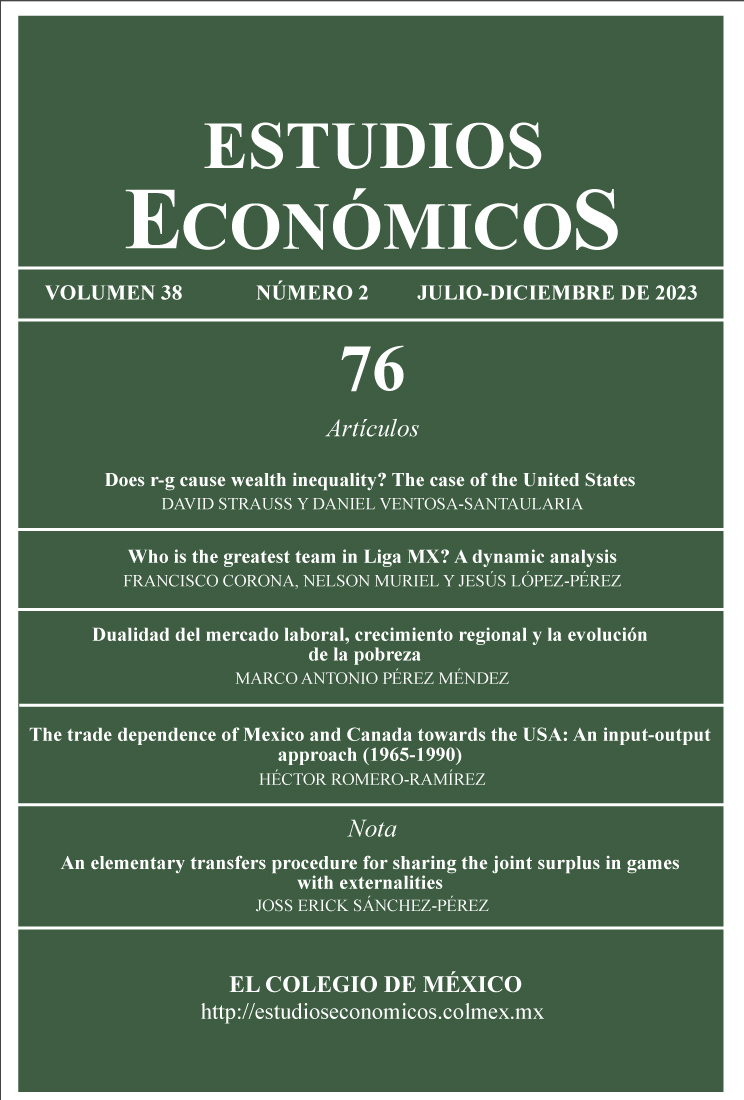Published 2023-07-20
Keywords
- financial variables,
- football,
- greatness,
- popularity,
- principal components analysis
How to Cite
Abstract
In this paper, we conduct a statistical procedure to respond a very frequent question in Mexican sport media TV: Who is the greatest team in Liga MX? For this purpose, we apply Principal Components to a historical domestic and international results database along with variables related to the fans and the market value of the franchises’ roster from 2011-2019. The results allow us to analyze the evolution of the “greatness” latent variable over time, concluding that, in the window of time analyzed, Club América is the greatest team, followed by C.D. Guadalajara and C.F. Cruz Azul. Additionally, nowadays, Club Tigres de la Universidad Autónoma de Nuevo León and C.F. Monterrey displace teams like Deportivo Toluca F.C. and Club Universidad Nacional.
Downloads
References
- Ahn, S. and A. Horenstein. 2013. Eigenvalue ratio test for the number of factors, Econometrica, 81(3): 1203-1227. DOI: https://doi.org/10.3982/ECTA8968
- Bai, J. and S. Ng. 2004. A PANIC attack on unit roots and cointegration, Econometrica, 72(4): 1127-1177. DOI: https://doi.org/10.1111/j.1468-0262.2004.00528.x
- Bai, J. and S. Ng. 2013. Principal components estimation and identification of static factors, Journal of Econometrics, 176(1): 18-29. DOI: https://doi.org/10.1016/j.jeconom.2013.03.007
- Baker, R. and I. McHale. 2015. Time varying ratings in association football: The all-time greatest team is..., Journal of the Royal Statistical Society: Series A (Statistics in Society), 178(2): 481-492. DOI: https://doi.org/10.1111/rssa.12060
- Corona, F., N. Muriel, and G. González-Farías. 2021. Dynamic factor structure of team performances in Liga MX, Journal of Applied Statistics, 49(7): 1900-1912. DOI: https://doi.org/10.1080/02664763.2021.1881946
- Corona, F., J. Tena, and M. Wiper. 2017. On the importance of the probabilistic model in identifying the most decisive games in a tournament, Journal of Quantitative Analysis in Sports, 13: 11-23. DOI: https://doi.org/10.1515/jqas-2016-0013
- ESPN. 2019. Los cuatro 'grandes' de Liga MX fracasan en inferiores, https://www.espn.com.mx/futbol/mexico/nota/_/id/5296826/los-cuatro-grandes-de-liga-mx-fracasan-en-inferiores.
- Faitelson. 2017. "Animal" de liguilla, https://www.espn.com.mx/blogs/index?nombre=david_faitelson&entryID=3729412
- Georgievski, B. and L. Labadze. 2020. Success factors and revealed comparative advantage in the NBA, Journal of Physical Education and Sport, 20(6): 3420-3427.
- Georgievski, B., L. Labadze, and M.E. Aboelsoud. 2019. Comparative advantage as a success factor in football clubs: Evidence from the English Premier League (EPL), Journal of Human Sport and Exercise, 14(2): 292-314. DOI: https://doi.org/10.14198/jhse.2019.142.04
- Glickman, M. and H. Stern. 1998. A state-space model for national football league scores, Journal of the American Statistical Association, 43(441): 25-35. DOI: https://doi.org/10.1080/01621459.1998.10474084
- Jolliffe, I.M. 2010. Principal Component Analysis, New York, Springer. DOI: https://doi.org/10.1007/978-3-642-04898-2_455
- Maher, M.J. 1982. Modelling association football scores, Statistica Neerlandica, 36: 109-118. DOI: https://doi.org/10.1111/j.1467-9574.1982.tb00782.x
- Mikolajec, K., A. Maszczyk, and T. Zajkac. 2013. Game indicators determining sports performance in the NBA, Journal of Human Kinetics, 37(1): 145-151. DOI: https://doi.org/10.2478/hukin-2013-0035
- Onatski, A. 2010. Determining the number of factors from empirical distribution of eigenvalues, The Review of Economics and Statistics, 92(4): 1004-1016. DOI: https://doi.org/10.1162/REST_a_00043
- Stefani, R. and R. Pollard. 2007. Football rating systems for top-level competition: A critical survey, Journal of Quantitative Analysis in Sports, 3(3): 1-17. DOI: https://doi.org/10.2202/1559-0410.1071
- Stock, J.H. and M.W. Watson. 2011. Dynamic factor models, in M.P. Clements and D.F. Hendry (eds.), Oxford Handbook of Economic Forecasting, Oxford, Oxford University Press. DOI: https://doi.org/10.1093/oxfordhb/9780195398649.013.0003
- Velázquez-Guadarrama, C. and J.M. Hernández-Velázquez. 2022. Cambio de director técnico en el fútbol mexicano. Evidencia de 2009 a 2018, Estudios Económicos, 37(1): 149-170. DOI: https://doi.org/10.24201/ee.v37i1.428

